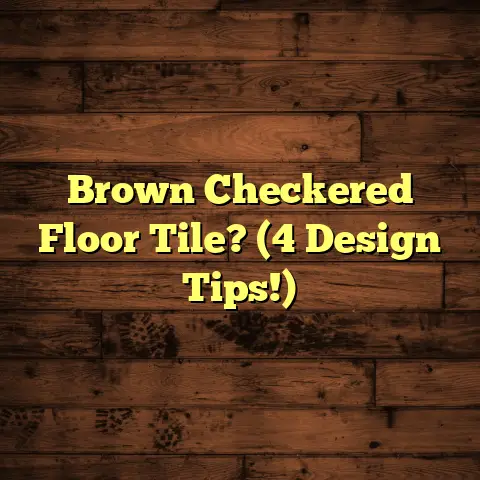Wood Floor To Carpet Threshold: Seamless Transition Tips? (Explained)
When was the last time you stumbled over a threshold between wood flooring and carpet?
It’s a common scenario that can lead to tripping hazards and an awkward visual transition.
Achieving a seamless connection between these two distinct flooring types is not just about aesthetics; it’s also about functionality and safety.
I’ve been in the flooring business for years, and I know just how important those transitions are.
Let’s chat about some effective tips I’ve picked up along the way, along with stories that might help you avoid pitfalls.
Understanding the Challenge
Creating a smooth transition from wood to carpet can present unique challenges.
It’s not just about choosing the right materials; factors like height differences, textures, and colors come into play.
My First Experience
One of my earliest projects involved a charming couple who wanted to transform their living room with hardwood floors while keeping the adjacent bedroom carpeted.
They were excited but anxious about how everything would come together.
At that time, I wasn’t as experienced with transitions, and I didn’t have the right tools handy, which led to some frustrating moments.
I had to redo the initial installation—an experience that taught me a valuable lesson about preparation.
Choosing the Right Transition Strip
Selecting an appropriate transition strip is one of the first decisions you’ll need to make.
There are several options available, each with its own benefits and considerations:
- T-Molding: Ideal when the heights of the two flooring types are similar.
It creates a clean look and allows for some movement. - Reducer: If your wood floor is higher than the carpet, a reducer strip helps create a smooth slope down to the carpet.
- Threshold: More decorative, used where the two floors meet at a doorway.
My Recommendations
I usually recommend T-molding for most cases because it provides flexibility and is aesthetically pleasing.
Just be sure to measure carefully before purchasing.
Proper measurement can save you time and frustration.
Installation Tips
Measurement is Key
Before you start cutting anything, take accurate measurements.
I can’t stress this enough!
Instead of eyeballing it, use a tape measure for precise dimensions.
I once miscalculated a length by just half an inch, resulting in an awkward-looking transition that had to be redone.
Cutting Your Transition Strip
Once you have your measurements down, cutting your transition strip comes next.
I often use a miter saw for straight cuts and a jigsaw for more intricate shapes.
This ensures everything fits snugly against both flooring types.
When cutting T-molding or reducers, consider using a fine-toothed blade to avoid chipping the surface of the wood.
Securing the Transition Strip
After cutting, securing the strip is crucial.
I usually use adhesive or screws, depending on the type of transition strip.
If you opt for adhesive, ensure that both surfaces are clean and dry for the best bond.
Aesthetic Considerations
Have you ever noticed how a poorly matched threshold can draw attention for all the wrong reasons?
It’s all about making the transition visually appealing too.
When I worked on that couple’s house, we chose a dark wood T-molding that complemented their hardwood floors without clashing with the carpet.
The result?
A seamless look that made both areas feel connected rather than separate.
Color Matching
Don’t underestimate color matching!
It’s not just about materials; it’s about tones too.
I had a client who insisted on using a bright white transition strip against light oak flooring.
It looked jarring!
We eventually settled on a warmer tone that harmonized beautifully with both surfaces.
Texture Consideration
Texture plays an important role in creating a seamless look.
The smoothness of hardwood can contrast sharply with the plushness of carpet.
To soften this transition, consider using a transition strip that has a slight bevel or rounded edge to ease the visual difference.
Cost Considerations
Cost is always an important factor in any flooring project.
While I can estimate costs using various methods, I’ve found FloorTally to be incredibly helpful in providing accurate estimates based on local material and labor rates.
It has saved me from overestimating expenses and allowed me to present realistic budgets to my clients right from the start.
For example, during that couple’s renovation, I was able to itemize costs efficiently—covering everything from wood floor installation to the transition strip and labor costs—all calculated in real-time through FloorTally.
This transparency built trust and made decision-making smoother.
Breaking Down Costs
Here’s how I typically break down costs for a project involving wood-to-carpet transitions:
- Material Costs:
- Hardwood flooring: $3 – $10 per sq ft
- Carpet: $2 – $6 per sq ft
- Transition strips: $1 – $5 per linear foot
- Labor Costs:
- Installation of hardwood: $2 – $4 per sq ft
- Carpet installation: $1 – $3 per sq ft
- Additional Costs:
- Adhesives or fasteners: $0.10 – $0.50 per sq ft
- Underlayment (if needed): $0.50 – $1 per sq ft
Estimating Total Costs
To estimate total costs accurately, calculate the square footage of each area involved and multiply by the appropriate rates.
Remember to factor in waste—around 10% extra material is standard practice to account for mistakes or repairs.
Maintenance After Installation
After you’ve got everything installed, maintenance is key to longevity.
- Regular Cleaning: Vacuuming or sweeping regularly keeps dirt from accumulating in that threshold area.
- Occasional Resealing: If you used a wood transition strip, consider resealing it every few years to maintain its finish.
I learned this lesson the hard way when a transitional area in my own home started showing wear due to neglect.
A little upkeep goes a long way!
Dealing with Height Differences
Height differences between wood flooring and carpet can be challenging to manage.
If your hardwood is significantly higher than your carpet, you might need to use a thicker reducer strip or even add an underlayment beneath the carpet to raise it slightly.
My Experience with Height Issues
I once worked on a project where the hardwood flooring was about ¾ inch taller than the carpet.
The homeowner was adamant about maintaining both materials without compromising either one’s integrity or aesthetics.
After some trial and error, we settled on using a custom-crafted reducer strip that blended perfectly with both surfaces.
Creating Visual Interest
When transitioning from wood to carpet, consider how to create visual interest rather than simply relying on functionality alone.
Patterns and Shapes
If you’re feeling adventurous, think about incorporating patterns in the transition area itself.
For instance, laying down some tiles or using different shapes for your transition strip can add character and style.
Color Contrasts
Using contrasting colors can also highlight the transition area effectively without being jarring.
A dark wood T-molding against light-colored carpet can create an elegant frame for each space.
Personal Anecdotes: Successes and Challenges
Throughout my years in flooring, I’ve faced numerous successes and challenges that have shaped my approach to handling wood-to-carpet transitions.
A Successful Project
One memorable project involved remodeling an old Victorian home where we had to work with uneven floor heights due to settling over decades.
We used custom-built risers and T-molding that matched the intricate woodwork around door frames—resulting in not just functionality but also an incredible visual appeal that delighted the homeowners.
A Challenging Project
On another occasion, I worked on a commercial office space where the client wanted flexible flooring solutions due to constant changes in layout.
The challenge here was ensuring that transitions remained adaptable without being disruptive or unattractive.
After much experimentation, we opted for modular transition strips that could be easily replaced without extensive downtime.
Practical Tips for DIY Enthusiasts
If you’re considering tackling this project yourself, here are some practical tips based on my experience:
- Gather All Tools Before Starting: Don’t start until you have everything you need—measuring tape, saws, adhesive, etc.
- Practice Cutting: If you’re new to cutting materials, practice on scrap pieces first to get comfortable with your equipment.
- Use Quality Materials: Invest in high-quality transition strips; they’ll pay off in durability and appearance.
- Ask for Help: Don’t hesitate to bring in an experienced friend or professional if you’re unsure about any part of the process.
- Take Breaks: Flooring work can be physically demanding; take breaks to avoid fatigue and ensure careful work.
Conclusion
Creating a seamless connection between wood flooring and carpet can be rewarding when done correctly.
From selecting the right materials to ensuring precise installation and considering ongoing maintenance, each step plays a vital role in achieving that polished look homeowners desire.
Have you had any experiences with flooring transitions?
What tips do you have?
Let’s keep this conversation going!
Whether you’re a seasoned contractor or a DIY enthusiast, there’s always more to learn and share when it comes to perfecting those small but crucial details in home improvement projects.





